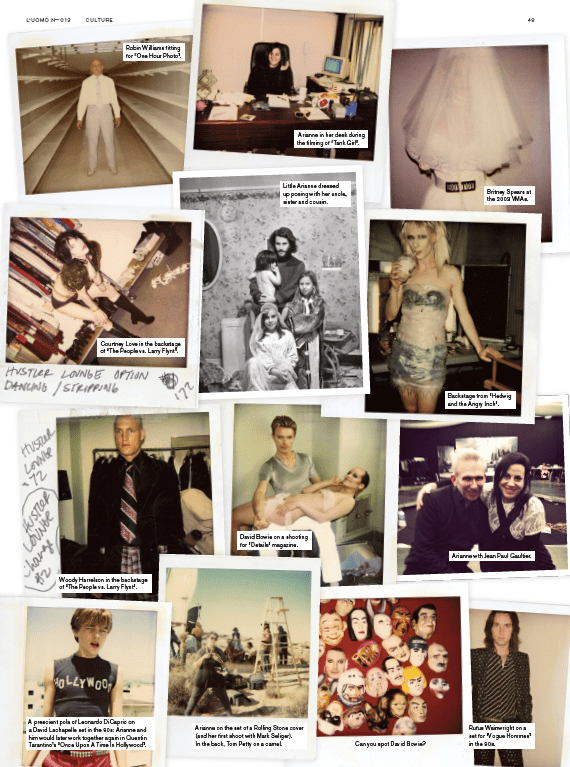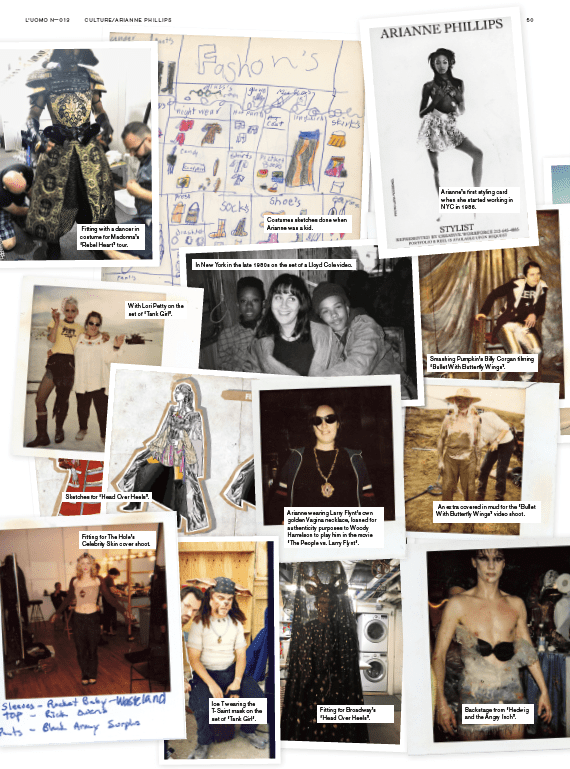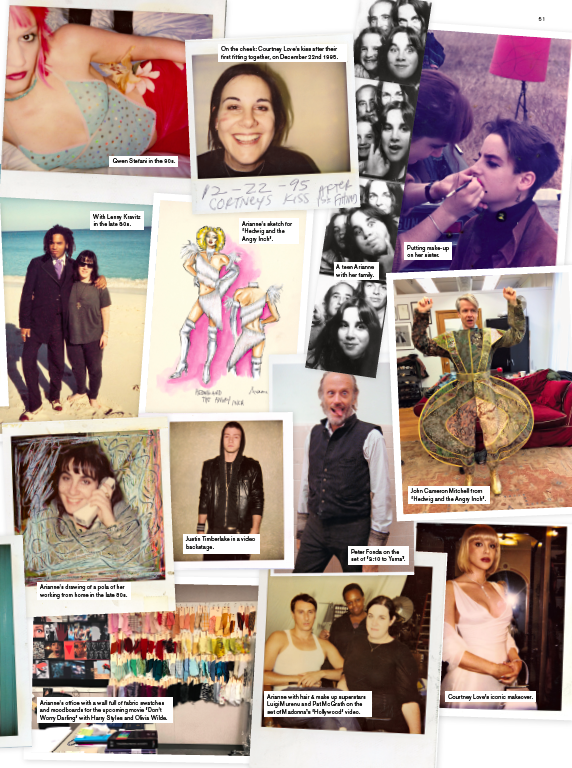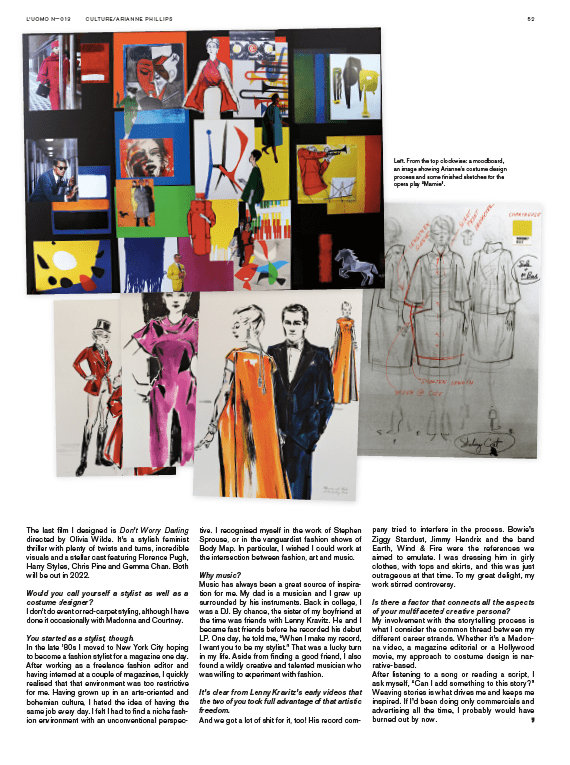By Michele Fossi
More than any other contemporary shaper of wearable image, Arianne Phillips’ range extends far beyond the traditional silos of costume. Whether on film, in fashion, or as a worn visual accompaniment to some of the world’s greatest pop artists, Phillips’ evocative vision is unique – and this is how it was honed.
Born in Los Angeles and raised in Northern California, Arianne Phillips started making fashion sketches as a child. After returning to her home town in 1991, she rapidly established herself as one of Hollywood’s most sought-after costume designers, working on such widely diverse productions as The Crow (1994) and Milos Forman’s The People Vs. Larry Flynt (1996), and receiving Oscar nominations for her contributions to James Mangold’s Walk the Line (2005), Madonna’s W.E. (2011) and Quentin Tarantino’s Once Upon a Time in Hollywood (2019). In this interview with L’Uomo Vogue, Phillips speaks about her love of Hollywood – “A playground of sunshine and optimism, where everyone is encouraged to tune into their inner creativity.”
When we were arranging this interview, you mentioned you were busy with a special project. Can you say what it was?
I was helping a young, talented American designer, Henri Alexander Levy, set up his sixth fashion show for Paris Fashion Week. Truth be told, I have yet to adjust to being the mentor [laughs]. And I love this guy. He’s got a wild creative nature. He’s actually a visual artist and a painter. In 2018, he launched his brand called Enfants Riches Déprimés and inaugurated a flagship store in Paris. We were introduced by Courtney Love, of all people. She saw something in him and suggested that I help him with his debut in fashion. Courtney, whom I met on the set of one of my first Hollywood movies, The People vs. Larry Flynt, seems to have this magical ability to introduce me to the right people. It was she who introduced me to Madonna, too. I ended up collaborating with Miss Ciccone for over two decades, working on the costume design of six of her world tours and – I lost count! – around 25 of her videos.
You live in the heart of Hollywood. Was it always your dream to move there?
In my youth, the idea of living in LA never crossed my mind! I used to believe Hollywood represented a conventional, superficial lifestyle. My primary source of artistic inspiration at a young age was Europe, specifically London. However, I quickly changed my mind when I moved here to make The Crow.
That first cinema experience was pretty traumatic, though.
The death of Brandon Lee during the filming of The Crow was a devastating experience. Besides being the angel who got me my first Hollywood gig, he was also a close friend.
You’ve said that your creative autonomy was born in Hollywood, away from the street and art culture of New York.
Hollywood’s influence on culture is often underestimated: too superficial, not intellectual enough. While the truth is, Hollywood, as a mental construct, is a powerful tool for forging your own creative identity. For me, Hollywood represented an uncharted territory where I had no sense of belonging and where I was free to create as I pleased.
So New York’s fashion and art institutions in the ’80s were more rigid compared to LA?
They were, and I was in dire need of a setting that would allow me to explore my own ideas. If throughout my career I’ve been drawn to great provocateurs, whether Jean-Baptiste Mondino, Madonna or Quentin Tarantino, it’s probably because I, too, belong to that category. In particular, I like to be a provocateur with myself, by always pushing myself to the limit, creatively speaking. The best place for me to do it is here. Moving to Hollywood was also my way of rebelling against my family. In the 1970s, my parents moved from Los Angeles to Northern California, in search of a more alternative, experimental and bohemian environment to raise their family. Ironically, it was ultimately Hollywood, not San Francisco or New York, that gave me the freedom and optimism to be who I wanted to be.
Over the past three decades, you’ve worked on dozens of film productions. Do you feel a special affection for any of them?
Hedwig and the Angry Inch [the 2001 rock musical written and directed by John Cameron Mitchell] is no doubt the movie I found most inspirational. Although Sundance picked it as one of their audience favourites, it was a flop in theatres. But almost two decades later, it has taken on a life of its own, very similar to The Rocky Horror Picture Show. It explores gender fluidity and self-transformation, two topics I’ve always been interested in as a costume designer. In 2014, the directors and writers brought it to Broadway with Neil Patrick Harris in the lead role.
This show was your Broadway debut, and it secured you a Tony nomination too. Since then, you’ve fully integrated theatre into your kaleidoscopic career. In 2018 you were back on Broadway with “Head Over Heels”. In the same year, you designed the costumes for Nico Muhly’s opera “Marnie”, staged at the English National Opera (2017) and the Met (2018).
My first professional theatre experience was a play in London in 2000 in the West End with Madonna called Up For Grabs. I would include her tours in the category of theatre experiences since these are all very theatrical renditions of her music.
What projects do you have in the pipeline?
I’m currently designing the Broadway musical The Devil Wears Prada, with music by Elton John and directed by the uber-talented Anna Shapiro.
The last film I designed is Don’t Worry Darling directed by Olivia Wilde. It’s a stylish feminist thriller with plenty of twists and turns, incredible visuals and a stellar cast featuring Florence Pugh, Harry Styles, Chris Pine and Gemma Chan. Both will be out in 2022.
Would you call yourself a stylist as well as a costume designer?
I don’t do event or red-carpet styling, although I have done it occasionally with Madonna and Courtney.
You started as a stylist, though.
In the late ’80s I moved to New York City hoping to become a fashion stylist for a magazine one day. After working as a freelance fashion editor and having interned at a couple of magazines, I quickly realised that that environment was too restrictive for me. Having grown up in an arts-oriented and bohemian culture, I hated the idea of having the same job every day. I felt I had to find a niche fashion environment with an unconventional perspective. I recognised myself in the work of Stephen Sprouse, or in the vanguardist fashion shows of Body Map. In particular, I wished I could work at the intersection between fashion, art and music.
Why music?
Music has always been a great source of inspiration for me. My dad is a musician and I grew up surrounded by his instruments. Back in college, I was a DJ. By chance, the sister of my boyfriend at the time was friends with Lenny Kravitz. He and I became fast friends before he recorded his debut LP. One day, he told me, “When I make my record, I want you to be my stylist.” That was a lucky turn in my life. Aside from finding a good friend, I also found a wildly creative and talented musician who was willing to experiment with fashion.
It’s clear from Lenny Kravitz’s early videos that the two of you took full advantage of that artistic freedom.
And we got a lot of shit for it, too! His record company tried to interfere in the process. Bowie’s Ziggy Stardust, Jimmy Hendrix and the band Earth, Wind & Fire were the references we aimed to emulate. I was dressing him in girly clothes, with tops and skirts, and this was just outrageous at that time. To my great delight, my work stirred controversy.
Is there a factor that connects all the aspects of your multifaceted creative persona?
My involvement with the storytelling process is what I consider the common thread between my different career strands. Whether it’s a Madonna video, a magazine editorial or a Hollywood movie, my approach to costume design is narrative-based. After listening to a song or reading a script, I ask myself, “Can I add something to this story?” Weaving stories is what drives me and keeps me inspired. If I’d been doing only commercials and advertising all the time, I probably would have burned out by now.
Published in L’Uomo Vogue, November 2021





